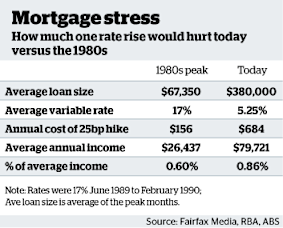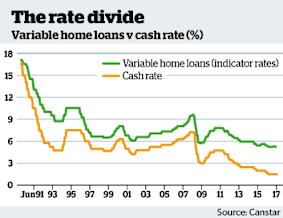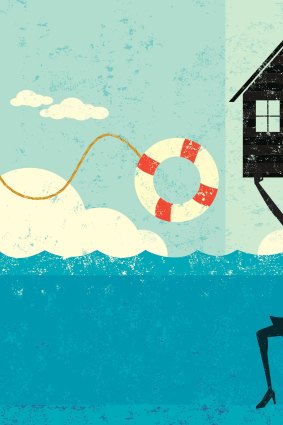Ask anyone who had a mortgage how they felt when variable rates hit 17 per cent and you'll still see the pain etched on their face.
But the "achy '80s" (and very early '90s) were nothing on the hurt rate rises would inflict today. And there's been pundit talk of an imminent eight of them, while the Reserve Bank has confirmed a "neutral" setting would be that same 200 basis points higher.
My calculations show that from our historically low official levels – the average variable rate is way down at 5.25 per cent – each rate rise would eat up 43 per cent more of income than it did at the mortgage-interest peak last century.
Such has been the failure of wages to keep pace with the spectacular growth in property prices … yet a (grudging) national willingness to use debt to chase them.

People run into problems if they earn more than $18,200 during the year and they work two jobs while claiming the tax-free threshold on both.
When mortgage holders were enduring the agony of the 1980s, various ABS figures reveal the average Australian home loan was only 2.5 times the typical income: $67,350 versus $26,437 (note I've averaged the loan size over the 10 months the RBA home loan indicator rate stayed at 17 per cent: June 1989 to March 1990).
Today, the loan-to-take-home has spiked to almost five times, or $380,000 against $79,721. Indeed, we are poised to smash our former borrowing record, possibly as early as next week, of $382,800 in November 2015. (And mortgagors in far-more-expensive Sydney and Melbourne are probably crying into their coffees right now.)
What it all means is that although one 25 basis point rate rise wiped out just 0.6 per cent of someone's income nearly three decades ago (costing $156 a year or $13 a month), that figure is closer to a whole per cent today ($684 or $57). Four of them would now add $2760 to the typical annual repayment, and suck up 3.5 per cent of income (versus 2.4 per cent in the '80s/'90s).
But the truly frightening thing about rate rises packing a larger comparative punch is it puts the knock-out blow sooner.

Our equivalent to the infamous 17 per cent interest? A home loan rate of just 8 per cent.
In other words, it's at 8 per cent that mortgage repayments would grow to consume 44 per cent of our incomes – the heart-breaking proportion homeowners were forced to hand over previously.

And let's not forget we were at a 7.8 per cent mortgage rate as recently as October 2011 – post-credit crack-up. Just a year after the dramatic Lehman Brothers collapse, the Reserve Bank rose official rates seven times in 13 months to "normalise" them after the "emergency", twice-as-high-as-today setting (it was 3 per cent versus 1.5 per cent).
For repayments, 8 per cent would mean an average $2933 a month or $35,196 a year … the 44 per cent of income. Back in the 1980s, mortgage payments reached the same painful proportion of income at $968 a month or $11,616 a year, though remember a straight dollar comparison with today is pointless because of inflation.

Paying off your principal as much as you can now is a good way to prepare for higher rates.
For a current repayment benchmark, at 5.25 per cent it's an average $2277 a month – or $27,324 a year. Which means the typical home owner is already on the verge of tipping into "mortgage stress", defined as committed beyond one-third of their income. The average repayment percentage, even at our current record low rates, is 34 per cent.
But before you brace for this decade turning into the torturous teens, I don't see eight official rate rises coming quickly – particularly now inflation has come in soft.
However, APRA's investor loan crackdown has seen interest ascend on its own. The inset 25-year chart from Canstar, the data house that's been around longest, shows it's by no means new for mortgage rates to diverge from the cash rate.
And however hikes happen, it's only 275 basis points of them (effectively 11 increases) that would see us in the same cost-critical scenario as home owners in the '80s and '90s … with repayments sapping the identical proportion of income.
You know what's the best way to avoid all of this? Pay down your principal – and fast. Because on the positive, it's possibly a once-in-a-lifetime opportunity to do it for the least amount of money ever.
Nicole Pedersen-McKinnon is a commentator and educator who presents her Smart Money Start, fun financial literacy incursion, in high schools around Australia. Follow Nicole on Facebook.